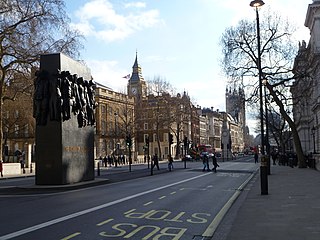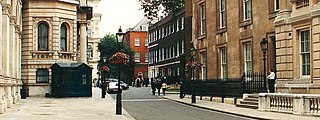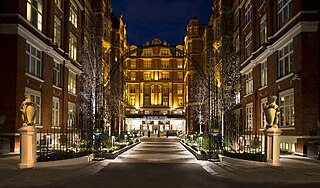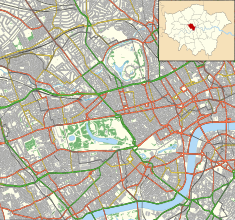
Mayfair is an area of London, England, in the City of Westminster. It is in Central London and part of the West End. It is between Oxford Street, Regent Street, Piccadilly and Park Lane and one of the most expensive districts in the world.

Whitehall is a road and area in the City of Westminster, Central London, England. The road forms the first part of the A3212 road from Trafalgar Square to Chelsea. It is the main thoroughfare running south from Trafalgar Square towards Parliament Square. The street is recognised as the centre of the Government of the United Kingdom and is lined with numerous departments and ministries, including the Ministry of Defence, Horse Guards, the Cabinet Office, and much of the Foreign Office. Consequently, the name "Whitehall" is used as a metonym for the British civil service and government, and as the geographic name for the surrounding area.

The Strand is a major street in the City of Westminster, Central London. The street, which is part of London's West End theatreland, runs just over 3⁄4 mile (1.2 km) from Trafalgar Square eastwards to Temple Bar, where it becomes Fleet Street in the City of London, and is part of the A4, a main road running west from inner London.

Belgravia is a district in Central London, covering parts of the areas of the City of Westminster and the Royal Borough of Kensington and Chelsea.

St Mary Aldermanbury was a parish church in the City of London first mentioned in 1181 and destroyed by the Great Fire of London in 1666. Rebuilt in Portland stone by Christopher Wren, it was again gutted by the Blitz in 1940, leaving only the walls standing. These stones were transported to Fulton, Missouri in 1966, by the residents of that town, and rebuilt in the grounds of Westminster College as a memorial to Winston Churchill. Churchill had made his Sinews of Peace, "Iron Curtain" speech in the Westminster College Gymnasium in 1946.

9 Downing Street is one of the buildings situated on Downing Street in the City of Westminster in London, England. It has been used as a separate address to the better known 10 Downing Street since 2001 for various government functions.

Northumberland Avenue is a street in the City of Westminster, Central London, running from Trafalgar Square in the west to the Thames Embankment in the east. The road was built on the site of Northumberland House, the London home of the Percy family, the Dukes of Northumberland between 1874 and 1876, and on part of the parallel Northumberland Street.

Vincent Square is a grass-covered square in Westminster, London, England. It is London's largest privately-owned square, covering 13 acres, lined with mature trees including London Planes. In among a network of backstreets, it chiefly provides playing fields for Westminster School, who own it absolutely; otherwise, it functions as a green lung and a view for the homes, hotel and other organisations adjoining. Nine of its adjoining buildings have been given strict statutory architectural recognition and protection. The Liberal Democrat Headquarters, housing one of Parliament's three largest political parties, is based at 1 Vincent Square.

Black Friday was a suffragette demonstration in London on 18 November 1910, in which 300 women marched to the Houses of Parliament as part of their campaign to secure voting rights for women. The day earned its name from the violence meted out to protesters, some of it sexual, by the Metropolitan Police and male bystanders.

The Jallianwala Bagh massacre, also known as the Amritsar massacre, took place on 13 April 1919. A large crowd had gathered at the Jallianwala Bagh in Amritsar, Punjab, British India, during the annual Baisakhi fair to protest against the Rowlatt Act and the arrest of pro-Indian independence activists Saifuddin Kitchlew and Satyapal. In response to the public gathering, the temporary brigadier general R. E. H. Dyer surrounded the people with his Gurkha and Sikh infantry regiments of the British Indian Army. The Jallianwala Bagh could only be exited on one side, as its other three sides were enclosed by buildings. After blocking the exit with his troops, Dyer ordered them to shoot at the crowd, continuing to fire even as the protestors tried to flee. The troops kept on firing until their ammunition was low and they were ordered to stop. Estimates of those killed vary from 379 to 1,500 or more people; over 1,200 others were injured, of whom 192 sustained serious injuries. Britain has never formally apologised for the massacre but expressed "deep regret" in 2019.

Shaheed Uddham Singh is a 1999 Indian Punjabi-language biographical film based on the life of Udham Singh, an Indian revolutionary who had witnessed the 1919 Amritsar massacre and wanted to avenge the mass killing of his countrymen. He was desperate to punish Michael O'Dwyer, the Lieutenant Governor of the Punjab for his involvement with the massacre. The film was theatrically released in India on 24 December 1999, just two days before Singh's birth centenary. The film was screened retrospective on 13 August 2016 at the Independence Day Film Festival jointly presented by the Indian Directorate of Film Festivals and Ministry of Defense, commemorating 70th Indian Independence Day.

A suffragette was a member of an activist women's organisation in the early 20th century who, under the banner "Votes for Women", fought for the right to vote in public elections in the United Kingdom. The term refers in particular to members of the British Women's Social and Political Union (WSPU), a women-only movement founded in 1903 by Emmeline Pankhurst, which engaged in direct action and civil disobedience. In 1906, a reporter writing in the Daily Mail coined the term suffragette for the WSPU, derived from suffragistα, in order to belittle the women advocating women's suffrage. The militants embraced the new name, even adopting it for use as the title of the newspaper published by the WSPU.

St. Ermin's Hotel is a four-star central London hotel adjacent to St James's Park Underground station, close to Westminster Abbey, Buckingham Palace, and the Houses of Parliament. The Grade II-listed late Victorian building, built as one of the early mansion blocks in the English capital, is thought to be named after an ancient monastery reputed to have occupied the site pre-10th century. Converted to a hotel in 1896–1899, it became during the 1930s, through the Second World War and beyond, a meeting place of the British intelligence services, notably the birthplace of the Special Operations Executive (SOE), and where notorious Cambridge Five double agents Philby and MacLean met their Russian handlers. St Ermin's is now part of Marriott Hotels' Autograph Collection. The hotel is owned by the family of Tei-Fu Chen, founder of Sunrider International.

The Suffragette Memorial is an outdoor sculpture commemorating those who fought for women's suffrage in the United Kingdom, located in the north-west corner of Christchurch Gardens, Victoria, London. The sculptors were Lorne McKean and Edwin Russell and the project was devised and supervised by the architect Paul Paget. The memorial was unveiled in 1970. It takes the form of a scroll in the shape of the letter S, created in fibreglass and finished in cold-cast bronze, placed on a conical plinth. The text of the scroll reads:
This tribute is erected by the Suffragette Fellowship to commemorate the courage and perseverance of all those men and women who in the long struggle for votes for women selflessly braved derision, opposition and ostracism, many enduring physical violence and suffering.

The Battle of Downing Street was a march of suffragettes to Downing Street, London, on 22 November 1910. Organized by Emmeline Pankhurst's Women's Social and Political Union, the march took place four days after Black Friday, a suffragette protest outside the House of Commons that saw the women violently attacked by police.

The Green Man is a Grade II listed public house at 57 Berwick Street, in London's Soho.

Westminster City Hall is a municipal building in Victoria Street in Westminster, London. It is the headquarters of Westminster City Council.

Warrington Crescent is a street in Maida Vale in London. Located in the City of Westminster, it is a crescent curving north eastwards from Warwick Avenue until it reaches a roundabout where it meets including Randolph Avenue, Sutherland Avenue and Lauderdale Road. Warrington Gardens and Formosa Street both lead westwards off Warrington Crescent.

The Old City Hall, also known as Cavell House and Pennine House, is a municipal building in Charing Cross Road in Westminster, London. The building, which is currently in commercial use, is a Grade II listed building.






















